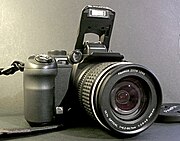
Digital cameras can do things film cameras cannot, displaying images on a screen immediately after they are recorded, storing thousands of images on a single small memory device, recording video with sound, and deleting images to free storage space.
Digital cameras are incorporated into many devices ranging from PDAs and mobile phones (called camera phones) to vehicles. The Hubble Space Telescope and other astronomical devices are essentially specialised digital cameras.
Compact digital cameras
Compact cameras are designed to be small and portable; the smallest are described as subcompacts or "ultra-compacts". Compact cameras are usually designed to be easy to use, sacrificing advanced features and picture quality for compactness and simplicity; images can usually only be stored using Lossy compression (JPEG). Most have a built-in flash usually of low power, sufficient for nearby subjects. Live preview is almost always used to frame the photo. They may have limited motion picture capability. Compacts often have macro capability, but if they have zoom capability the range is usually less than for bridge and DSLR cameras. They have a greater depth of field, allowing objects within a large range of distances from the camera to be in sharp focus. They are particularly suitable for casual and "snapshot" use.
Bridge cameras
Bridge or SLR-like cameras are higher-end digital cameras that physically resemble DSLRs and share with them some advanced features, but share with compacts the framing of the photo using live preview and small sensor sizes.
Bridge cameras often have superzoom lenses which provide a very wide zoom range, typically between 10:1 and 18:1, which is attained at the cost of some distortions, including barrel and pincushion distortion, to a degree which varies with lens quality. These cameras are sometimes marketed as and confused with digital SLR cameras since the appearance is similar. Bridge cameras lack the mirror and reflex system of DSLRs, have so far been fitted with fixed (non-interchangeable) lenses (although in some cases accessory wide-angle or telephoto converters can be attached to the lens), can usually take movies with sound, and the scene is composed by viewing either the liquid crystal display or the electronic viewfinder (EVF). They are usually slower to operate than a true digital SLR, but they are capable of very good image quality (with sufficient light) while being more compact and lighter than DSLRs. The high-end models of this type have comparable resolutions to low and mid-range DSLRs. Many of these cameras can store images in lossless RAW format as an option to JPEG compression. The majority have a built-in flash, often a unit which flips up over the lens. The guide number tends to be between 11 and 15.
Digital single lens reflex cameras
Digital single-lens reflex cameras (DSLRs) are digital cameras based on film single-lens reflex cameras (SLRs), both types are characterized by the existence of a mirror and reflex system. See the main article on DSLRs for a detailed treatment of this category.
Digital rangefinders
A rangefinder is a user-operated optical mechanism to measure subject distance once widely used on film cameras. Most digital cameras measure subject distance automatically using acoustic or electronic techniques, but it is not customary to say that they have a rangefinder. The term rangefinder alone is sometimes used to mean a rangefinder camera, that is, a film camera equipped with a rangefinder, as distinct from an SLR or a simple camera with no way to measure distance.
Professional modular digital camera systems
This category includes very high end professional equipment that can be assembled from modular components (winders, grips, lenses, etc.) to suit particular purposes. Common brands include Hasselblad and Mamiya. They were developed for medium or large format film sizes, as these captured greater detail and could be enlarged more than 35 mm.
Typically these cameras are used in studios for commercial production; being bulky and awkward to carry they are rarely used in action or nature photography. They can often be converted into either film or digital use by changing out the back part of the unit, hence the use of terms such as a "digital back" or "film back". These cameras are very expensive (up to $40,000) and are typically not used by consumers.
Line-scan camera systems
A line-scan camera is a camera device containing a line-scan image sensor chip, and a focusing mechanism. These cameras are almost solely used in industrial settings to capture an image of a constant stream of moving material. Unlike video cameras, line-scan cameras use a single array of pixel sensors, instead of a matrix of them. Data coming from the line-scan camera has a frequency, where the camera scans a line, waits, and repeats. The data coming from the line-scan camera is commonly processed by a computer, to collect the one-dimensional line data and to create a two-dimensional image. The collected two-dimensional image data is then processed by image-processing methods for industrial purposes.
Line-scan technology is capable of capturing data extremely fast, and at very high image resolutions. Usually under these conditions, resulting collected image data can quickly exceed 100MB in a fraction of a second. Line-scan-camera–based integrated systems, therefore are usually designed to streamline the camera's output in order to meet the system's objective, using computer technology which is also affordable.
Line-scan cameras intended for the parcel handling industry can integrate adaptive focusing mechanisms to scan six sides of any rectangular parcel in focus, regardless of angle, and size. The resulting 2-D captured images could contain, but are not limited to 1D and 2D barcodes, address information, and any pattern that can be processed via image processing methods. Since the images are 2-D, they are also human-readable and can be viewable on a computer screen. Advanced integrated systems include video coding and optical character recognition (OCR).



No comments:
Post a Comment